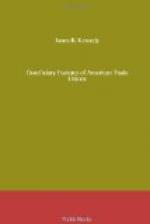The administration of the death benefit or of a system of insurance against death presents relatively few difficult problems. The local union reports the death to the national officials and certifies to the good standing of the deceased member in his local union. If the reports of national and local unions correspond and the deceased member is clear on the records of both local and national unions, the claim is approved by the national officers and payment is made to the designated beneficiary, or the legal heirs of the deceased. The report of the subordinate union to the national union, covering the case in point, contains a certificate validating the claim, sworn to before a notary public or commissioner by the president and the financial secretary, together with all documents upon which the local authorities based their decision or prayer for the payment of the claim. Upon receipt of an application for a claim the general secretary-treasurer, the general president, or both, examine it and, if satisfied as to its validity, order immediate payment; if the claim is questionable it is referred to the general executive board for final adjustment.[222]
[Footnote 222: Iron Molders’ Constitution, 1902 (Cincinnati, 1902), p. 41; Cigar Makers’ Constitution, 1896, fourteenth edition (Chicago, n.d.), sec. 151; Painters’ Constitution, 1906 (La Fayette, n.d.), sec. 151.]
The adjudication of disability claims is more difficult than that of death claims. Of the unions that pay disability insurance or benefits the Locomotive Engineers, the Railway Conductors, the Locomotive Firemen, the Railroad Trainmen, the Switchmen, the Maintenance-of-Way Employees, the Iron Molders, the Brotherhood of Carpenters, the Painters, and the Glass Workers specify the disabilities that constitute “total or permanent disability,” while the Wood-Workers and Metal Workers define disability simply by the resultant disqualification for “following the trade,"[223] In the latter group of unions the administrative officers have large discretionary power. The lack of more specific rules in such cases causes unsatisfactory administration and this in turn gives rise to general complaint.[224]




